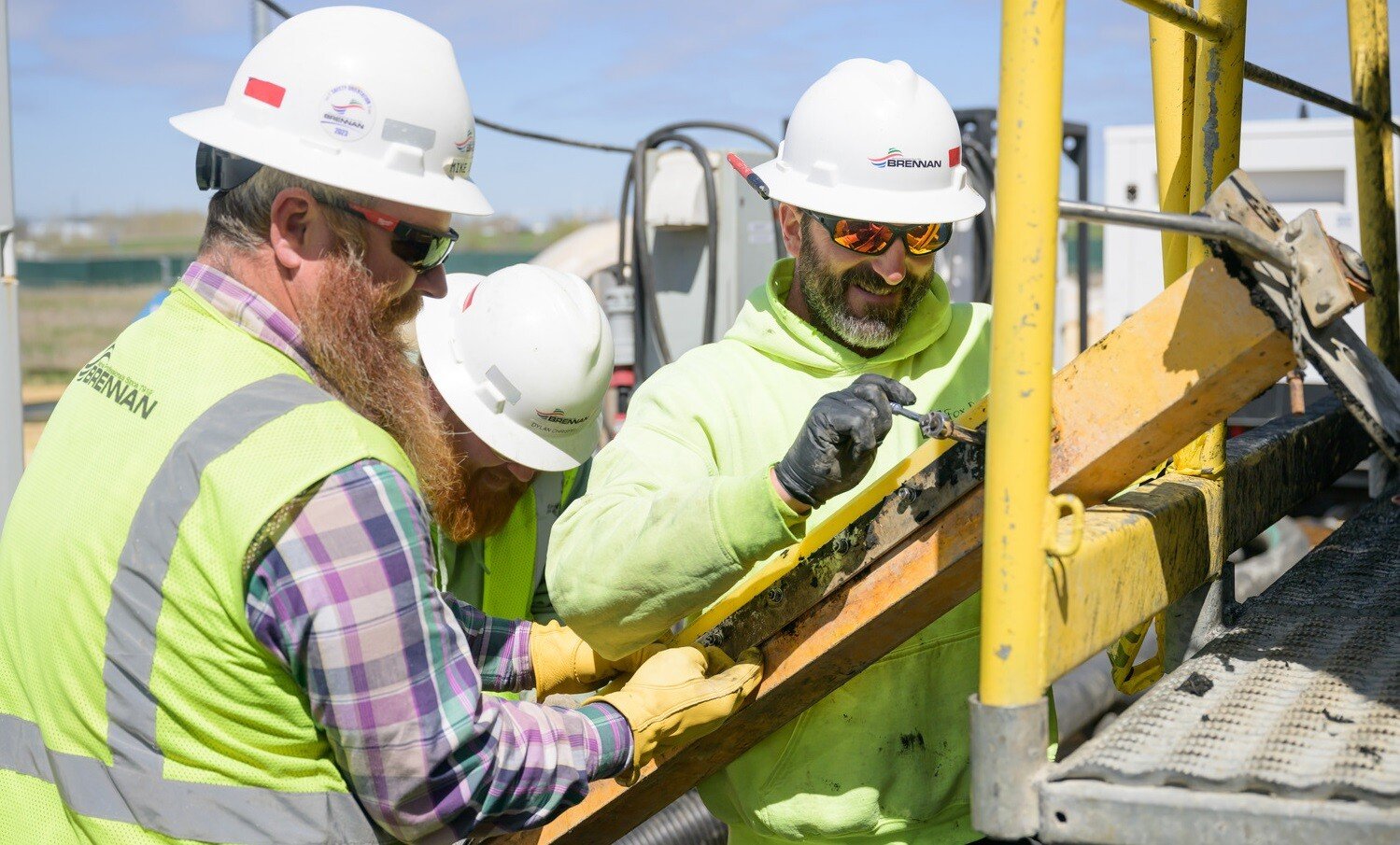Refinery Wastewater Pond Cleanup with Remote Dredging
We recently completed the cleanup of two wastewater ponds for a large producer of transportation fuels. Using a remotely controlled dredge, Brennan removed wastewater sludge from impoundments on the refinery site and dewatered the material with six 2-meter belt filter presses. The remotely controlled dredge added a layer of safety to the project, preventing any health risks that a Leverman might face if exposed to hydrogen sulfide gas released during the dredging process.
Innovative Use of Ferric Chloride for Hazard Mitigation
To treat the sludge, we conditioned the material with a combination of ferric chloride and polymer, both promoting dewatering. Ferric chloride also controls hydrogen sulfide, a hazardous, flammable, and toxic compound found in the sludge that could be released as a gas during the dewatering process, creating a potential safety hazard.
%20Remote%20Control%20Dredge-103_medium.jpg?width=1000&height=749&name=2024%20Pine%20Bend%20Refinery%20-%20e1)%20Remote%20Control%20Dredge-103_medium.jpg) Using this remote-controlled dredge, we safely removed wastewater sludge from 2 refinery wastewater ponds.
Using this remote-controlled dredge, we safely removed wastewater sludge from 2 refinery wastewater ponds.
Optimized Dewatering Solutions for Refinery Wastewater Sludge Management
Brennan designed a solution to chemically bind hydrogen sulfide by adding ferric chloride to the sludge while it was contained in the dredge pipe. This process effectively inactivated the foul-smelling gas and reduced the hazard to safe levels, with the added benefit of improving solids-water separation. By addressing the hazard before personnel exposure, the process ensured both safety and efficiency.
Mobile Belt Filter Presses Provide Efficient Dewatering On-Site
We used a belt filter press to dewater the dredged sludge mechanically. This equipment introduces conditioning chemicals to the slurry, allows for mixing, and flows the slurry over a fabric belt that loops through the machine. As the belt loops, water drains through, retaining solids on top. Rakes furrow the solids to further remove moisture.
%20Belt%20Press%20Dewatering%20Overview-110_medium.jpg?width=1000&height=667&name=2024%20Pine%20Bend%20Refinery%20-%20d)%20Belt%20Press%20Dewatering%20Overview-110_medium.jpg)
We used belt filter presses to mechanically separate treated dredged solids from water.
At this site, solids dropped off the press onto a stacking conveyor, which deposited them into dump trucks. Rinse water was captured and returned to the pond being dredged, while the dewatered material was hauled to a landfill for disposal by the owner.
Hydrogen Sulfide Management for Safety and Efficiency
The material contained hydrogen sulfide, which is known for its characteristic “rotten egg” odor. To address this, the owner contracted the landfill to stay open 24/7 during dredging. The potential for odors also influenced the decision to use belt filter press dewatering instead of geotextile tubes.
%20Cake%20Truck%20to%20Landfill-110_medium.jpg?width=1000&height=749&name=2024%20Pine%20Bend%20Refinery%20-%20l)%20Cake%20Truck%20to%20Landfill-110_medium.jpg) We kept our work area clean and clear by immediately disposing of dewatered wastewater material.
We kept our work area clean and clear by immediately disposing of dewatered wastewater material.
Our Project Engineer noted, “By shipping trucks as they filled, we never had a true stockpile of material on-site. This reduced the equipment needed to load the trucks and allowed for a smaller work area.”
Mechanical vs. Passive Dewatering: Key Advantages
One benefit of mechanical dewatering processes like belt filter presses is their efficiency. Unlike passive methods, such as geotextile tube dewatering, which can take weeks or months to dewater material sufficiently, belt filter presses produce truckable material immediately upon processing. However, mechanical methods have higher capital and operational costs than passive options. The equipment and processes you select must be tailored to meet the specific needs of a project.
Our Expertise in Wastewater Pond Operations
Brennan’s Senior Director of Environmental shared, “This was a unique project for Brennan, allowing us to assist the client through project design and implementation, showcasing our team’s knowledge of chemistry, wastewater pond operations, and mechanical dewatering methods.” We completed the project within the allotted schedule. This outcome underscores our team's resilience and expertise in overcoming unforeseen obstacles.
%20Water%20Return%20to%20Pool-105_medium.jpg?width=700&height=524&name=2024%20Pine%20Bend%20Refinery%20-%20m1)%20Water%20Return%20to%20Pool-105_medium.jpg) Returning water to the refinery wastewater pond.
Returning water to the refinery wastewater pond.
Commitment to Safety and Client Satisfaction in Environmental Projects
The successful cleanup of this refinery’s wastewater ponds highlights Brennan’s ability to tackle complex challenges, both in the design phase and on-site. By innovatively addressing hydrogen sulfide risks and managing the dewatering process efficiently, our team demonstrated a steadfast commitment to safety, environmental stewardship, and client satisfaction.
Refinery Dredging and Dewatering Photos
About J.F. Brennan Company
J.F. Brennan Company, Inc. (Brennan) is a family-owned marine construction firm specializing in environmental remediation, dam construction, commercial diving, harbor management, and submarine cable services. Working closely with public and private owners of water-based infrastructure since 1919, Brennan operates throughout the coastal and inland waterways of the United States.




